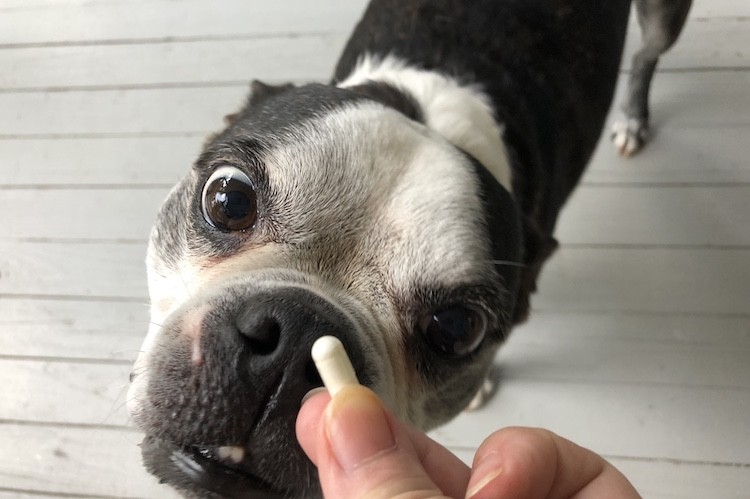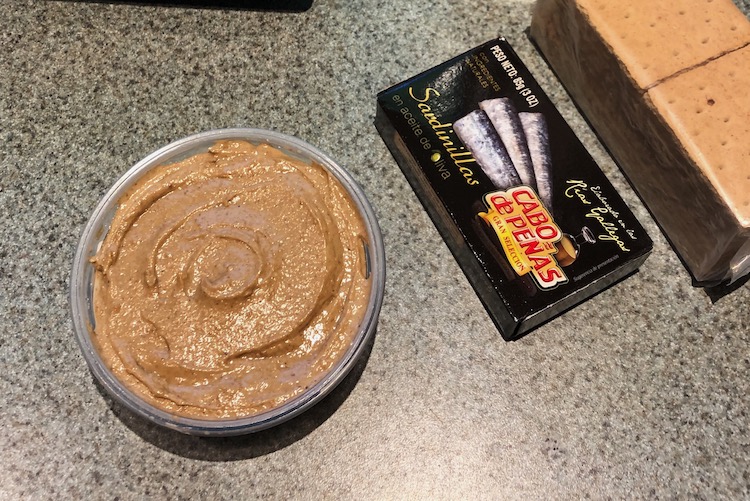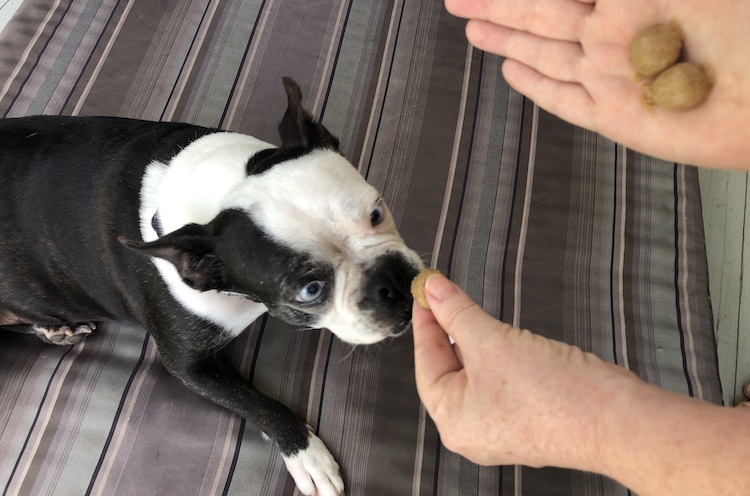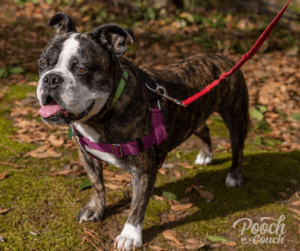Below is a photo of my dog, Indy. She was a master pill-cheeker. Toward the end of her life, she was taking medications and supplements 6 times a day. At some point each day, I had to give her more than one pill. If I “messed up” and she discovered the hidden pill, I’d have trouble getting the rest of her medication down the hatch. I wish I knew about different methods for giving medication to foster dogs back then.
To say she was a challenge is an understatement. I often had to resort to pilling her with my index finger down her throat which was not fun for her or me.

One by one, my novel foods for hiding pills failed. As Indy discovered the hidden pills, her list of hated foods grew: cream cheese, peanut butter, hot dogs, pill pockets, canned dog food, deli ham, american cheese slices, hamburger, scrambled egg, marshmallows.
Indy was so talented at cheeking her medication! She could act like she’d swallowed, but in reality, she hid the pill in her mouth. She’d walk away and spit the pill out in another room. That caused a problem, as Indy was taking some serious prescription medication that could harm another dog in the home. I really needed for Indy to take her meds.
Indy had an immune-mediated disease which manifested as severe allergies and joint degeneration.
I’ve learned a lot of different ways to take care of dogs since I became a foster parent for rescued Boston terriers. I’ve also given a lot, I mean A LOT of medications in the last 9 years.
I want to share with you a little of what I’ve learned and the steps I take when giving medications to foster dogs. If you don’t have foster dogs and you struggle with your personal pet, I know these steps can help you, too.
Table of Contents
Why Giving Medication to Foster Dogs is Sometimes Hard
Making Associations
In some ways, dogs have a simple approach to life and living: do what is pleasant and avoid what is unpleasant. Dogs also have an impressive ability to create some pretty strong associations with pleasant things and those less pleasant. These associations serve to alert a dog that something good or not so good is about to happen.
What are some of your dog’s other associations? How often does your dog come running when it hears plastic bags rattling? What does your dog do when you pick up your car keys? Put on your shoes? What happens when your dog sees you holding nail clippers or a bath towel? What does your dog associate with those activities? What does your dog think is about to happen? Is is pleasant, or unpleasant?

Otis is the total opposite of Indy when it comes to taking medication. His associations around food are all positive! All I have to do for most pills is either drop it in his meal of dry kibble (and supervise it!) or have him eat it out of my hand. Only when he once had to take Tramadol (a nasty tasting pill!) did I have to hide his pills in a ball of peanut butter. It is wonderful to have a dog that takes medications so easily!
Sassy used to be like Indy – suspicious of a ball of peanut butter or similar because it always meant there were pills hidden inside. Sassy also developed an association with the Benedryl bottle and ran into another room when I picked up the bottle. Mediation time was a daily struggle.
Now, giving medications to foster dogs like Sassy is easier because I made three changes.
Use Positive Associations When Giving Medications To Foster Dogs
As I mentioned above, dogs can form pretty strong associations, both positive and negative, and those associations can influence a dog’s preferences and decisions.
It is our job as caregivers to learn how help dogs form positive associations whenever we can.
Sadly, I didn’t know this when I was caring for Indy and her multiple illnesses.
Indy got to the point that when I opened a certain cabinet or rattled a particular container, she would leave the room. I’d have to go get her, she’d become limp like a wet noodle and would somehow become twice as heavy as I picked her up to carry her back to the kitchen to provide my good care.
I didn’t know I could manage medication time so that eventually Indy could have some choices in the matter. Not a choice of taking medications or not, but to have medications given to her in a pleasant way. I wish I’d known giving medication to dogs didn’t have to be so hard.
The Power of Negative Associations – Otis and the Flyswatter
While Otis has no problems taking medications, he does have a couple of negative associations that in 6-7 years, I have not been able to affect. One is with the flyswatter.
I have never, ever hit Otis with a flyswatter. I’ve never acted like I was going to hit Otis with a flyswatter. I rarely use the flyswatter to swat flies. But, Otis has a strong, immediate, negative association with a flyswatter. At the mere sight of the flyswatter, Otis runs and hides behind a chair. It makes me really sad.
Whatever happened that caused the negative association “flyswatter = bad” is not as important as the fact that he hasn’t let go of that flight response every time he sees one.
Associations can cause quite the imprint.
Every dog is going to need to take medications at some point in their life. Your foster dogs probably arrived to your home taking medications. Giving medications to foster dogs can be easy. I hope to help make medication time fun for you and your pups!
Safety First!
First things first. You need to know if you can break, halve, or crush a tablet or capsule. You need to know if a medication needs to be given on a full or empty stomach, or if there are any food restrictions with certain medications.
Know your dog’s medications and speak with your vet about your dog’s difficulties with taking medications before you implement a plan.
Some medications should never be broken in half or crushed or mixed in a slurry. This includes some medications that are manufactured as “extended release.” If your difficult-to-pill foster dog has been prescribed a large tablet or capsule, speak with the veterinarian about best ways to pill the dog or alternate medications or formulas to ensure medication compliance.
Step 1: You Gotta Figure Out That Food Your Dog Crazy Loves!
Find your dog’s most favorite food preference. This may take some time. If your dog is like my dog Indy was, it may already have a long list of “suspicious foods.” If so, avoid those foods at first. Later, you might be able to reintroduce some of those foods as medication-hiding options. Options are good when giving medications to foster dogs!
Sassy also has a list of “suspicious foods.” Thank goodness hers is a shorter list and she’s coming back around to liking some of foods, like peanut butter. Occasionally, I’m out of Sassy’s most favorite medication-hiding food and I’ll have to reach for the peanut butter. Sassy used to avoid peanut butter every time I offered it because it was suspicious for contraband.
What is Sassy’s most favorite food EVER? Stinky fish. Sardines, currently.
Again, finding this super-favorite food will be a bit of trial and error. Don’t give up. You are looking for a food that your dog loves more than it hates discovering the pill.
Once medication time is pleasant all the time, there is a greater chance the positive associations override the negative ones.

Some favorite food suggestions to try:
- Pate-style canned dog food. Now isn’t the time to use stew-style, chunky wet food. You want food you can roll up in a ball. I say the stinkier, the better.
- Pill hiding treats for dogs. Also known as Pill Pockets. These come in a variety of brands, flavors, and sizes. Or, you can make your own! HERE ARE SOME RECIPES
- Pill Paste – there are several brands and flavors on the market, and I have not tried any of them since I make my own pill paste using real food.
- Cheese – warm hard cheeses in your hand until it’s malleable. Soft cheese like cream cheese is slippery and can easily slide down the throat. *Be cautious if your dog is lactose intolerant or takes a lot of medications a day. You may opt for low-fat string cheese instead.
- Pieces of hotdog – This rarely worked for me because my pills were too big and the hotdog would break apart. It works great for some.
- Good ol’ peanut butter or another nut butter like almond butter. *Please read the label to make sure your peanut butter does NOT contain Xylitol, an ingredient deadly to dogs.
- Modern Dog Magazine suggests using chicken or turkey hearts, the ultimate natural pill pocket! You can either feed them raw or if raw isn’t your jam, you can cook the organs in some water. Find their instructions HERE.
(I am not knowledgeable about raw feeding, so before you feed your dog raw meat, consult with your veterinarian.)
Step 2: The How, When & Where of Giving Medications To Foster Dogs
These tips were a game changer for me and I hope they will also help you have an easier time giving medications to foster dogs.
Sassy is a success story! She used to hide when she heard pill bottles rattling. She used to spit out her medication. Now that she knows the sound of pill bottles means she is getting her most favorite treat, she comes running! Every time!
Pay attention to what your dog does when you walk near where you store the bottles. Does he or she open their eyes? Pay attention? Leave the room?
What about when you pick up the pill bottle or rattle it or open the top. Pay attention to each of these actions you do and see if your dog is giving a reaction.
You are identifying the associations.
Does your dog watch you put pills in the peanut butter? Then reject the peanut butter when you offer it? Try not letting your dog see you stuff meds into pill pockets. At least at first.
Let’s see if we can remove some of these associations for now. After we get the dog happy to play the “take your medicine game” we might be able to help them forget all about those negative associations they used to have. Then, giving medications to foster dogs can be fun for them.
For now, try the following suggestions:
Store The Medication Away From Where You Feed
I used to keep medications stored right next to where I prepare the dog’s meals. Makes sense, right? Often, medications are given with food and it’s easy to have it all right there in the same place.
Consider keeping the dog medications in a totally different place and dose out the pills when your dog isn’t around.
OR… do not give your dog access to your meal prep/medication prep station. This may be the best plan, since the anticipation surrounding meals can sometimes cause scuffles between foster dogs.
Don’t Rattle The Pill Bottles When the Dog Can Hear It
If you noticed that your dog pays attention to you rattling the pill bottle, then avoids you — change this. Do not let your dog hear you rattling a bunch of pill bottles right before you give medication. Both Indy and Sassy formed negative associations with this sound and it made medication administration harder.
Take The Pills Out Of the Bottle/Container Well In Advance
With Sassy, I pulled out the pills from the pill bottle an hour or so before medication time. Sassy eventually learned that the sound of rattling pills meant nothing.
Step 3: Play The “Take Your Medicine” Game
Give it a better name, though!
The first few times you play this game with your dog, DO NOT PUT PILLS IN the most-favorite-food-on-the-planet you discovered back in step 1. We aren’t ready for that part, yet. Patience, Grasshopper!
Using your dog’s food of choice, make 3 small balls, about a half-inch in diameter or maybe a little smaller.

Find your excited, squeaky voice and call your dog over. “Want a treat?” or whatever your T.R.E.A.T. word is.
Offer your dog one of the food balls. Let your dog sniff, lick, and investigate this morsel of goodness that you already know they love. While they work through their doubts, questioning, and suspicions, you stay relaxed and positive.

As soon as the dog takes the treat, offer the second. Do not hesitate! Hopefully, your dog won’t either and will eagerly swallow the first treat and take the second treat because the first one was oh-so-good. Follow the second treat with the third, kinda like you are chasing tequila with salt and lime.
Fun, right? Your dog should think so!
Now, say “yippee!” and call it game over. Play the game a few more times during the day.
Hint: Remember to slightly adjust the amount of food in your dog’s meals to prevent weight gain!
Giving Medications To Foster Dogs Using Best Game EVER!
At this time, your dog has no idea that one day soon there might be pills in the food balls. Your foster dog is enjoying the game and the yummy treats you are giving them. Perfect.
Invite your dog to play this game several times a day for several days.
When you think you are ready, at medication time, hide a small pill in the second treat. Make sure your treat ball is of the right size to both cover the pill completely, and be easily swallowed whole without chewing the treat ball.
Once your dog is easily taking medications using this treat game, keep playing the game anyway! If you can, change up the foods during non-medication times so the dog looks forward to the game.
I’ll repeat that again – your goal is for the dog to like the game so they are not thinking about the medication!
Troubleshooting
This method will not work with every dog, but I hope it works with your dog. Reasons it may not work with your dog are:
- The medications are too big, are unable to be broken in half, or you have to give liquid medication.
- Your dog has some food resource guarding issues or hasn’t yet learned how to take treats gently.
- Your dog always chews foods.
- Your dog has food intolerances and is on a strict limited ingredient dog food. *Don’t give up! There is a way to make food balls using the foods your dog can digest. Be persistent and creative! Hopefully you will find a solution so that giving medications to foster dogs is easy for you, too!
Alternatives for Giving Dogs Medications
Empty Gel Capsules
Empty gel capsules are awesome! Not only can they be used as a training tool to help your dog accept take medication more easily, you can use empty gel capsules to put medication inside. This is especially helpful if your dog is prescribed bitter tasting medications like Metronidazole or Tramadol.
A Slurry
If your dog’s medication can be crushed (check with your vet, please!) You can mix the crushed or powdered medication in a slurry and, using a syringe, feed the slurry to your dog.
In my experience, using the syringe to get the slurry to the back of the throat is more effective than letting the dog lick the slurry from the tip of the syringe.
A Pill Gun
I’ve never used a pill gun. The idea is to put the pill into the “gun” (which looks like a long, slender syringe), open the dog’s mouth, place the end of the gun/pill at the back of the dog’s throat, and release the pill.
It seems it is less uncomfortable and quicker than pilling a dog using a finger.
Have any of you used a pill gun? Share your experiences with me!
Your Finger
I’ve pilled a dog using this method many, many times and I definitely could improve my technique. That said, I would still use caution when pilling a new foster dog using this method, and I would immediately cease using this method if your foster dog gives you any early warning signs or indication they might bite you. Contact your veterinarian or animal behaviorist for assistance.
Note: Medication refusal is not an option for your dog, so – if you are early on in the process of changing your dog’s associations with taking medications, you will have to resort to a different way to get your dog to swallow a pill. My advice is to wait and put some distance between the “take your medication” game and using – to be blunt – force. Separating the game from using a pill gun or your finger will help your dog not form any negative associations with the food balls.
Make sure you factor in any possible wait time so that giving medications to foster dogs is done on time.
Your Veterinarian
Your veterinarian wants you to be successful in administering medications. If you are having problems getting your foster dog to take medications, do not hesitate to contact him or her for help.

Find The Fun in Giving Medications To Foster Dogs
If you have a dog that is challenging to pill, I’m with you! I know the struggle, the frustration, and the sadness that you have to ask your dog to do something they dread. Giving medications to foster dogs should be easy and fun.
Making a game out of medication time has made all the difference in the world for Sassy and I! Using treats that are eye-popping good absolutely helped changed Sassy’s negative associations with taking medication to happy associations. She now dances at the sound of the pill bottles.
Changing how I prepared her medications reduced the opportunities for her to make new negative associations.
Good luck to you and let me know your dog’s favorite foods or what makes medication time easy for you and your pup!
Resources
How To Give Your Pet A Pill
13 Tricks To Get Your Uncooperative Dog To Take A Pill
Making The Medicine Go Down: Giving A Dog A Pill
How To Foster Dogs
How To Foster Dogs – 10 Skills You Need To Know
How To Choose A Dog Rescue Agency
Let Your Foster Dog Go – Tips For Adoption


